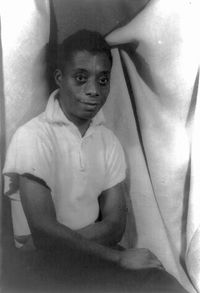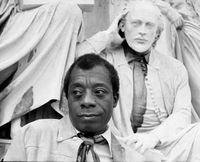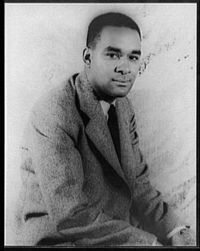James Baldwin (writer)
| James Arthur Baldwin | |
|---|---|
 James Baldwin, photographed by Carl Van Vechten, 1955 |
|
| Born | August 2, 1924 , U.S. |
| Died | November 30, 1987 (aged 63) Saint-Paul de Vence, France |
| Occupation | Writer, Novelist, Essayist, Poet, Playwright, |
| Nationality | American |
| Genres | fiction; non-fiction |
|
Influences
|
|
|
Influenced
Suzan-Lori Parks, Toni Morrison, Bell Hooks, Susan Straight
|
|
James Arthur Baldwin (August 2, 1924 – November 30, 1987) was an American novelist, writer, playwright, poet, essayist and civil rights activist.
Most of Baldwin's work deals with racial and sexual issues in the mid-20th century in the United States. His novels are notable for the personal way in which they explore questions of identity as well as the way in which they mine complex social and psychological pressures related to being black and homosexual well before the social, cultural or political equality of these groups was improved.[1]
Contents |
Early life
When Baldwin was an infant, his mother, Emma Berdis Joynes, moved to Harlem, New York, where she married a preacher, David Baldwin, who adopted James. The family was poor; and James and his adoptive father had a tumultuous relationship. James Baldwin attended the prestigious DeWitt Clinton High School in the Bronx, where he worked on the school magazine together with Richard Avedon.[2] At the age of 14, he joined the Pentecostal Church and became a Pentecostal preacher.
When he was 17 years old, Baldwin turned away from his religion and moved to Greenwich Village, a New York City neighborhood, famous for its artists and writers. Here, he studied at The New School, finding an intellectual community within the university. Supporting himself with odd jobs, he began to write short stories, essays, and book reviews, many of which were later collected in the volume Notes of a Native Son (1955).
Baldwin's expatriation
During his teenage years in Harlem and Greenwich Village, Baldwin began to recognize his own homosexuality. In 1948, disillusioned by American prejudice against blacks and homosexuals, Baldwin left the United States and departed to Paris, France. His flight was not just a desire to distance himself from American prejudice. He fled in order to see himself and his writing beyond an African American context and to be read as not "merely a Negro; or, even, merely a Negro writer"[3]. Also, he left the United States desiring to come to terms with his sexual ambivalence and flee the hopelessness that many young African American men like himself succumbed to in New York.[4]
In Paris, Baldwin was soon involved in the cultural radicalism of the Left Bank. His work started to be published in literary anthologies, notably Zero [5], which was edited by his friend Themistocles Hoetis and which had already published essays by Richard Wright.
He would live as an expatriate in France for most of his later life. He would also spend some time in Switzerland and Turkey.[6][7] During his life and after it, Baldwin would be seen not only as an influential African American writer but also as an influential exile writer, particularly because of his numerous experiences outside of the United States and the impact of these experiences on Baldwin's life and his writing.
Literary career

In 1953, Baldwin's first novel, Go Tell It on the Mountain, an autobiographical bildungsroman, was published. Baldwin's first collection of essays, Notes of a Native Son appeared two years later. Baldwin continued to experiment with literary forms throughout his career, publishing poetry and plays as well as the fiction and essays for which he was known.
Baldwin's second novel, Giovanni's Room, stirred controversy when it was first published in 1956 due to its explicit homoerotic content.[8] Baldwin was again resisting labels with the publication of this work:[9] despite the reading public's expectations that he would publish works dealing with the African American experience, Giovanni's Room is exclusively about white characters.[9] Baldwin's next two novels, Another Country and Tell Me How Long the Train's Been Gone, are sprawling, experimental works[10] dealing with black and white characters and with heterosexual, homosexual, and bisexual characters.[11] These novels struggle to contain the turbulence of the 1960s: they are saturated with a sense of violent unrest and outrage.
Baldwin's lengthy essay Down at the Cross (frequently called The Fire Next Time after the title of the book in which it was published)[12] similarly showed the seething discontent of the 1960s in novel form. The essay was originally published in two oversized issues of The New Yorker and landed Baldwin on the cover of Time magazine in 1963 while Baldwin was touring the South speaking about the restive Civil Rights movement. The essay talked about the uneasy relationship between Christianity and the burgeoning Black Muslim movement. Baldwin's next book-length essay, No Name in the Street, also discussed his own experience in the context of the later 1960s, specifically the assassinations of three of his personal friends: Medgar Evers, Malcolm X, and Martin Luther King, Jr.
Baldwin's writings of the 1970s and 1980s have been largely overlooked by critics. The assassinations of black leaders in the 1960s, Eldridge Cleaver's vicious homophobic attack on Baldwin in Soul on Ice, and Baldwin's return to southern France contributed to the sense that he was not in touch with his readership. Always true to his own convictions rather than to the tastes of others, Baldwin continued to write what he wanted to write. His two novels written in the 1970s, If Beale Street Could Talk and Just Above My Head, placed a strong emphasis on the importance of black families, and he concluded his career by publishing a volume of poetry, Jimmy's Blues, as well as another book-length essay, The Evidence of Things Not Seen, which was an extended meditation inspired by the Atlanta Child Murders of the early 1980s.
Social and political activism
After his return to the United States from France and a subsequent trip to the South in 1962, Baldwin aligned himself more closely with the ideals of the Congress of Racial Equality (CORE) and the Student Nonviolent Coordinating Committee (SNCC). In 1963 he conducted a lecture tour of the South for CORE, traveling to locations like Durham and Greensboro, North Carolina and New Orleans, Louisiana. During the tour, he lectured to students, white liberals, and anyone else listening about his racial ideology, an ideological position between the "muscular approach" of Malcolm X and the nonviolent program of Martin Luther King Jr..[13]
At this time, Baldwin threw himself into the civil rights movement. In 1963, along with prominent figures like Lorraine Hansberry and Harry Belafonte and other civil rights figures, Baldwin met with then Attorney General Robert F. Kennedy to discuss the moral implications of the civil rights movement. Although most of the attendees of this meeting left feeling "devastated," the meeting was an important one in voicing the concerns of the civil rights movement and it provided exposure of the civil rights issue not just as a political issue but also as a moral issue. [14]. Baldwin also made a prominent appearance at the Civil Rights March on Washington, D.C. on August 28th, 1963, also with Belafonte, as well as with long time friends Sidney Poitier and Marlon Brando.
Inspiration and relationships

One source of support came from an admired older writer Richard Wright, whom he called "the greatest black writer in the world". Wright and Baldwin became friends for a short time and Wright helped him to secure the Eugene F. Saxon Memorial Award. Baldwin titled a collection of essays Notes of a Native Son, in clear reference to Wright's novel Native Son. However, Baldwin's 1949 essay "Everybody's Protest Novel" ended the two authors' friendship[15] because Baldwin asserted that Wright's novel Native Son, like Harriet Beecher Stowe's Uncle Tom's Cabin, lacked credible characters and psychological complexity. However, during an interview with Julius Lester,[16] Baldwin explained that his adoration for Wright remained: "I knew Richard and I loved him. I was not attacking him; I was trying to clarify something for myself".
1949 was also the year he met and fell in love with Lucien Happersberger. The boy was seventeen-year-old, and the two became very close, until Happersberger's marriage three years later, an event that left Baldwin devastated.[17] Lucien Happersberger died on August 21, 2010 in Switzerland.
Another major influence on Baldwin's life was the African-American painter Beauford Delaney. In The Price of the Ticket (1985), Baldwin describes Delaney as "the first living proof, for me, that a black man could be an artist. In a warmer time, a less blasphemous place, he would have been recognized as my teacher and I as his pupil. He became, for me, an example of courage and integrity, humility and passion. An absolute integrity: I saw him shaken many times and I lived to see him broken but I never saw him bow".
Baldwin was a close friend of the singer, pianist and civil rights activist Nina Simone. Together with Langston Hughes and Lorraine Hansberry, Baldwin was responsible for making Simone aware of the civil rights movement that was forming at that time to fight racial inequality. He also provided her with literary references that influenced her later work.
Baldwin also had an influence on the work of the French painter Philippe Derome who he met in Paris at the beginning of the 1960s.
Maya Angelou called Baldwin her "friend and brother", and credited him for "setting the stage" for the writing of her 1969 autobiography, I Know Why the Caged Bird Sings.[18]
Death
On November 30, 1987 Baldwin died from esophageal cancer in Saint-Paul-de-Vence. He was buried at the Ferncliff Cemetery in Hartsdale, near New York City.
Legacy
Baldwin's influence on other writers has been profound: Toni Morrison edited the Library of America two volume editions of Baldwin's fiction and essays, and a recent collection of critical essays links these two writers.
In 1987, Kevin Brown, a photo-journalist from Baltimore, founded the National James Baldwin Literary Society. The group organizes free public events celebrating Baldwin's life and legacy.
In 1992, Hampshire College in Amherst, Massachusetts, established the James Baldwin Scholars program, an urban outreach initiative, in honor of Baldwin, who taught at Hampshire in the early 1980s. The JBS Program provides talented students of color from underserved communities an opportunity to develop and improve the skills necessary for college success through coursework and tutorial support for one transitional year, after which Baldwin scholars may apply for full matriculation to Hampshire or any other four-year college program.
In 2002, scholar Molefi Kete Asante listed James Baldwin on his list of 100 Greatest African Americans.[19]
In 2005 the USPS created a first-class postage stamp dedicated to him which featured him on the front, and on the back of the peeling paper had a short biography. One of Baldwin's richest short stories, "Sonny's Blues", appears in many anthologies of short fiction used in introductory college literature classes.
Works

- Go Tell It on the Mountain (semi-autobiographical novel; 1953)
- The Amen Corner (play; 1954)
- Notes of a Native Son (essays; 1955)
- Giovanni's Room (novel; 1956)
- Nobody Knows My Name: More Notes of a Native Son (essays; 1961)
- Another Country (novel; 1962)
- A Talk to Teachers (essay; 1963)
- The Fire Next Time (essays; 1963)
- Blues for Mister Charlie (play; 1964)
- Going to Meet the Man (stories; 1965) published in the UK by Michael Joseph, dustjacket designed by David Battle.
- Tell Me How Long the Train's Been Gone (novel; 1968)
- No Name in the Street (essays; 1972)
- If Beale Street Could Talk (novel; 1974)
- The Devil Finds Work (essays; 1976)
- Just Above My Head (novel; 1979)
- Sonny's Blues (poems; 1983)
- The Evidence of Things Not Seen (essays; 1985)
- The Price of the Ticket (essays; 1985)
- Harlem Quartet (novel; 1987)
Together with others:
- Nothing Personal (with Richard Avedon (photogr.)) (1964)
- A Rap on Race (with Margaret Mead) (1971)
- One day when I as lost (orig.: A. Haley; 1972)
- A Dialogue (with Nikki Giovanni) (1973)
- Little Man Little Man: A Story of Childhood (with Yoran Cazac, 1976)
Notes
- ↑ Jean-François Gounardoo, Joseph J. Rodgers (1992). The Racial Problem in the Works of Richard Wright and James Baldwin. Greenwood Press. p 158 p 148-200
- ↑ Staff. "Richard Avedon", The Daily Telegraph, October 2, 2004. Accessed September 14, 2009. "He also edited the school magazine at DeWitt Clinton High, on which the black American writer James' Baldwin was literary editor."
- ↑ James Baldwin, "The Discovery of What it Means to be an American," in The Price of the Ticket: Collected Nonfiction, 1948-1985 (New York:St. Martin's Marek, 1985), 171.
- ↑ James Baldwin, “Fifth Avenue, Uptown” in The Price of the Ticket: Collected Nonfiction, 1948-1985 (New York: St. Martin’s/Marek, 1985), 206.
- ↑ Zero: a review of literature and art, Issues 1-7. Arno Press, A New York Times Company. 1974. ISBN 0405017537. http://books.google.com/?id=9wdVDKAZZFoC&pg=PP5&lpg=PP5&dq=New+York+Times+'Zero'+Themistocles+Hoetis&q=New%20York%20Times%20'Zero'%20Themistocles%20Hoetis. Retrieved 2010-04-04.
- ↑ "James Baldwin," MSN Encarta. Archived 2009-10-31.
- ↑ Zaborowska, Magdalena (2008). James Baldwin's Turkish Decade: Erotics of Exile. Duke University Press. ISBN 0822341441.
- ↑ Field, Douglas. Passing as a Cold War novel : anxiety and assimilation in James Baldwin's Giovanni's room. In: American Cold War culture / edited by Douglas Field. Edinburgh : Edinburgh University Press, 2005.
- ↑ 9.0 9.1 Lawrie Balfour (2001). The Evidence of Things Not Said: James Baldwin and the Promise of American Democracy. Cornell University Press. ISBN 978-0-8014-8698-2. page 51
- ↑ Miller, D. Quentin. James Baldwin American Writers Retrospective Supplement II, ed. Jay Parini. Scribner's, 2003, 1-17
- ↑ Paul Goodman (1962-06-24). "Not Enough of a World to Grow In (review of Another Country)". The New York Times. http://www.nytimes.com/books/98/03/29/specials/baldwin-country.html.
- ↑ Sheldon Binn (1963-01-31). "Reivew of The Fire Next Time". The New York Times. http://www.nytimes.com/books/98/03/29/specials/baldwin-fire.html.
- ↑ David Leeming, James Baldwin: A Biography (New York: Henry Holt, 1994), 134.
- ↑ David Leeming, James Baldwin: A Biography
- ↑ Michelle M. Wright '"Alas, Poor Richard!": Transatlantic Baldwin, The Politics of Forgetting, and the Project of Modernity', James Baldwin Now, ed. Dwight A. McBride, New York University Press, 1999, page 208
- ↑ "Baldwin Reflections". New York Times. http://www.nytimes.com/books/98/03/29/specials/baldwin-reflections.html.
- ↑ Winston Wilde, Legacies of Love p.93
- ↑ Angelou, Maya (1987-12-20). "A brother's love". The New York Times. http://www.nytimes.com/books/98/03/29/specials/baldwin-angelou.html?_r=2&oref=slogin&oref=login. Retrieved 2008-10-08.
- ↑ Asante, Molefi Kete (2002). 100 Greatest African Americans: A Biographical Encyclopedia. Amherst, New York. Prometheus Books. ISBN 1-57392-963-8.
Published as
- Early Novels & Stories: Go Tell It on the Mountain, Giovanni's Room, Another Country, Going to Meet the Man (Toni Morrison, ed.) (Library of America, 1998) ISBN 978-1-88301151-2.
- Collected Essays: Notes of a Native Son, Nobody Knows My Name, The Fire Next Time, No Name in the Street, The Devil Finds Work, Other Essays (Toni Morrison, ed.) (Library of America, 1998) ISBN 978-1-88301152-9
External links
- Gwin, Minrose. "Mourning Medgar: Justice, Aesthetics, and the Local" March 11, 2008. Southern Spaces
- James Baldwin Photographs and Papers Selected manuscripts, correspondence, and photographic portraits from the Beinecke Rare Book and Manuscript Library at Yale University
- Works by or about James Baldwin (writer) in libraries (WorldCat catalog)
- Comprehensive Resource of James Baldwin Information
- James Baldwin: The Price of the Ticket distributed by California Newsreel
- "An Open Letter to My Sister, Angela Y. Davis" by James Baldwin
- Baldwin's American Masters page
- Baldwin's C-Span page on American Writers
- Baldwin in the Literary Encyclopedia
- Audio files of speeches and interviews at UC Berkeley
- See Baldwin's 1963 film Take This Hammer, made with Richard O. Moore, about African American civil rights in San Francisco.
- Video: Baldwin debate with William F. Buckley (via UC Berkeley Media Resources Center)
- Guardian Books "Author Page", with profile and links to further articles
- The James Baldwin Collective in Paris, France
- Transcript of interview with Dr. Kenneth Clark
- James Baldwin at Find a Grave
|
||||||||||||||||||||